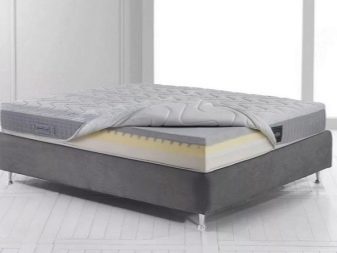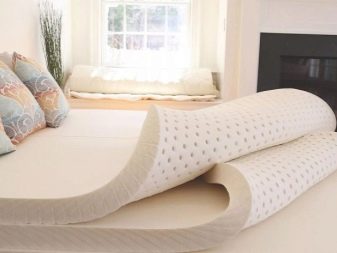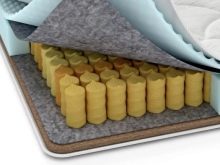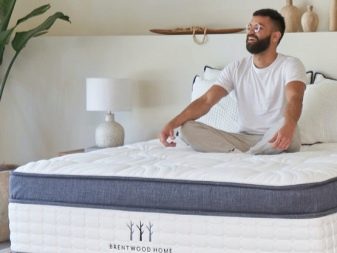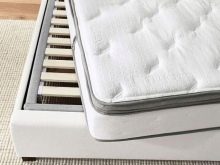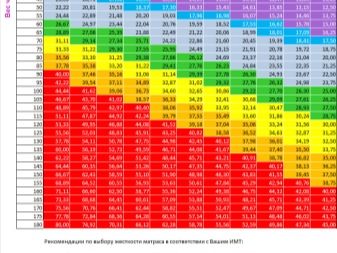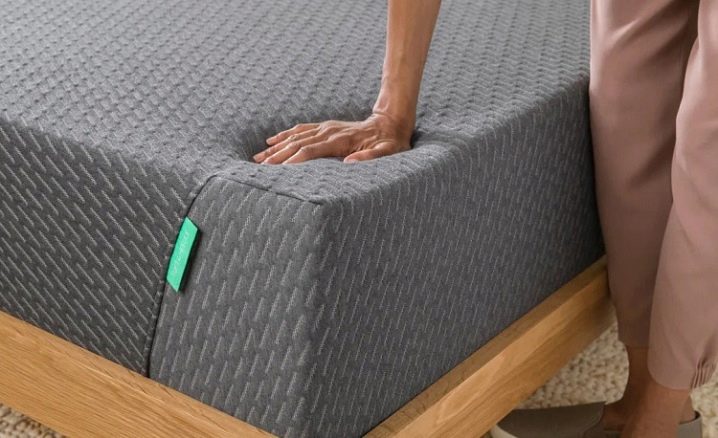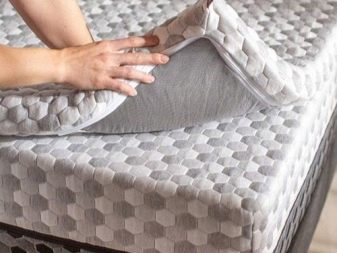What is the hardness of mattresses and which one to choose?
Despite the outward simplicity of mattresses, it can be quite difficult to choose the right model. It is especially difficult to determine the rigidity of the product: it can be very different, which baffles many buyers. The material presented to the reader will help to find out which of the options to give preference to.
What does it depend on?
The key factor in determining the firmness of a mattress is its contents. If the design of the product involves the presence of springs, the following features may be important:
- elasticity;
- sizes;
- number;
- mutual arrangement.
Also important is the specificity of the spring block, which can be dependent or independent. The first option provides for the adhesion of all elements into a single structure, while the second consists of separate parts (thus providing point support for the spine).
Mattress filler plays an equally important role, especially in springless models. As for the most popular materials, these include the following types.
- Latex. The main advantages are durability and ease of use. The elasticity of this material is also worthy of mention, allowing it to support the spine with maximum efficiency.
- Coira. It is a strong fiber derived from the coconut intercarp. It is most often used in hard mattresses. The coir's resistance to pathogenic microflora, which guarantees its long-term operation (15 years or more), also deserves attention.
- Polyurethane foam. The main advantage of this synthetic material is its versatility, which makes it possible to produce mattresses of any hardness. However, most often polyurethane foam is used in soft products. There is only one obvious drawback of such a filler - a relatively short service life (about 10 years).
Practice shows that most mattress models use several layers, each of which performs its own functions. The material that occupies the maximum volume is of decisive importance.
Species overview
Depending on the degree of firmness, all mattresses are conventionally divided into 5 categories.
- Tough. They have the greatest resistance to external loads, and therefore they almost do not bend under the weight of a person.
- Medium hard. They guarantee the support of the spine, sufficient in the vast majority of cases, and have a positive effect on the condition of the muscles.
- Average. A versatile option that is a balance between hard and soft decisions.
- Moderately soft. Provide complete relaxation of the musculoskeletal system, which is explained by their weakness.
- Soft. They easily bend under human weight, accurately repeating all the curves of the figure. The rigidity of such products is minimal, which has a positive effect on breathing and blood flow.
Also on the market are adjustable models, the degree of rigidity of which allows you to change their design.
How to determine?
Most often, the firmness of the mattress is indicated by the manufacturer in the product description. A consultant engaged in the sale of goods can also clarify the parameter of interest. If the buyer does not have enough information received or he doubts its reliability.
It is enough to consider a few basic points.
- The soft mattress flexes easily with any pressure - even the slightest. Also, such products have a memory effect, thanks to which they remember the curves of the figure of a sleeping person.Most often soft models are springless. The optimal filler is natural latex.
- In most cases, moderately soft mattresses are also produced without springs. It is convenient and pleasant to lie on such products, because their structure provides uniform support for the spinal column.
- The number of models of medium firm mattresses is the largest. Independent box spring solutions are especially popular as they are ideal for double beds. You can “understand” such a product by sensations that represent the “golden mean” between softness and hardness. As for fillers, the combined version with coir and latex is most in demand.
- The design of medium-hard mattresses most often involves the presence of a spring block. You can also find models without it - in the structure of such products there are only layers of filler (latex and coir).
- The material of hard mattresses is almost always coconut fiber. The hardness of the model is determined by the thickness of the filler.
As a rule, store consultants allow customers to lie on the mattress they are interested in, and therefore should not refuse this opportunity. Listening to your own feelings, choosing the right option can be faster and easier.
The absence of discomfort after being on the tested product serves as a signal to purchase it.
What rigidity should you choose?
One of the main factors determining the choice of a mattress of the required firmness is the age of its future owner. Depending on the period of a person's life, the musculoskeletal system requires a different attitude towards itself, which boils down to taking into account simple recommendations.
- Up to 1 year. The best solution is a rigid model without springs. This is because the baby's spine is just forming, and choosing a softer product can lead to poor posture.
- 1-3 years. It is desirable that the mattress for a baby of this age also be springless. The maximum stiffness is not needed - the medium-hard or medium version is enough.
- 3-12 years old. The presence of springs in the design of the product is at the discretion of the child's parents. The optimal firmness of the mattress, on which it is good to sleep, is medium.
- 12-25 years old. At this age, the spinal column continues to form (albeit with a lower intensity), and therefore soft models are still not recommended. Medium hardness products are still optimal. If a person has problems with being overweight, he can use a medium-hard mattress.
- 25-50 years old. Various options are available. Personal preference, body weight and health status can influence the choice of a particular model.
- After 50 years. It is better to refuse the use of rigid products. Optimal solutions are moderate-mild or mild options.
The second condition that should be considered when buying a mattress is the body weight of its owner. For adults, a simple rule is relevant: the more weight, the tougher the product used should be.
- Up to 55 kg. Both spring and springless models with pronounced or moderate softness are recommended. Latex and polyurethane foam are the most suitable fillers (struttofiber can be used as an alternative).
- 55-90 kg. Medium hardness is ideal for most applications. If a spring block is present, an independent variation is desirable. The filler is selected at the discretion of the future owner.
- More than 90 kg. The best solution is a firm mattress without springs. The optimal filler is coir, an alternative to which can be latex.
Also, people with a significant body weight can take models with a reinforced spring block that can withstand increased loads. The last point, which must be taken into account when choosing the desired rigidity, is the health status of the owner of the product.
In the presence of severe pathologies of the musculoskeletal system, it is advisable to discuss this moment with a doctor - in order to avoid possible exacerbations. Otherwise, the following general principles apply:
- in the presence of severe pain in the lower back, hard mattresses cannot be used;
- for people suffering from osteochondrosis and / or curvature of the spine, rigid models with an orthopedic effect are most suitable;
- with pathologies of the shoulder or cervical spine, it is justified to use hard or semi-rigid mattresses.
Another condition that determines the choice of a suitable product is the position that a lying person is used to taking. For those who love rest on their stomach, it is reasonable to get a medium-hard model, and those who prefer sleeping on their side or back should look at softer mattresses.
How to soften a hard mattress?
Sometimes it happens that the initially suitable model starts to seem too solid. Most often this is due to changes in the human body, although in some cases the cause is changed taste preferences. One of the solutions to this problem can be the use of a topper - an orthopedic product located above the base mattress. With its help, you can significantly reduce the stiffness, making the rest more comfortable.
The following materials are used as filler for toppers.
- Polyurethane foam. Models with such a filling are inexpensive and very soft, and their main disadvantage is low wear resistance.
- Structofiber or holofiber. These materials combine both synthetic and natural fibers to provide optimal functionality. The hardness of the toppers made of them is average.
- Memorix (memory foam). A solution with first-class orthopedic qualities. As a rule, memorix products have a small thickness (about 4 cm) and a moderate level of rigidity. The cost is relatively high.
- Natural latex. Like the previous material, it has excellent orthopedic properties and medium rigidity. Other advantages are resistance to deformation and full heat transfer.
It is important to take into account that the correct selection of the topper directly depends on the weight of the human body (a product with a thickness of 5 cm can withstand about 80 kg).
In addition, you can soften the mattress with your own hands. To solve this problem, you need to purchase a mat made of a material suitable for softness. Its dimensions must correspond to the dimensions of the converted product.
If the latter has a removable cover, it is enough to remove it, place the softening layer on top, and then put it back on. In the case of a non-removable outer casing, it should be carefully ripped open at the seam and, after placing the mat, sewn back on.

